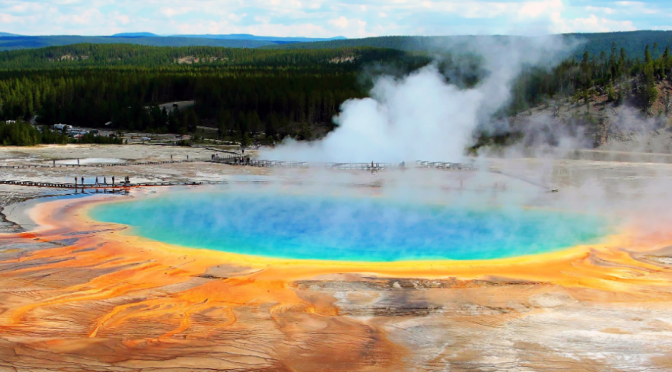by Phil Knight
One of the best things about Bozeman is its location close to Yellowstone National Park, the world’s first national park and still one of the most amazing places on the planet. People come from all over the world to experience Yellowstone, but you can jump in your car and be at the north or west entrance in an hour and a half.
Yellowstone sprawls across a high plateau in the heart of the Rockies. Within the two-million-acre park is a vast and diverse landscape which will take some time to absorb. Plan to make repeated trips there and see it in its many moods and seasons. Spectacular rivers and falls, wide open valleys, geyser and hot springs, endless forests, plateaus, cliffs, canyons, and peaks combine in sublime and timeless scenery.
Geothermal Features
 |
| Geothermal activity in Yellowstone |
Seething, bubbling, steaming, stewing… Yellowstone is unique on Earth for its diversity, and sheer number, of geothermal features. Also known as geysers, hot springs, mud pots, and fumaroles, they are fueled by the immense Yellowstone Volcanic Caldera. Over 10,000 distinct thermal features turn Yellowstone into a wonderland like no other.
Waterfalls
With over 300 waterfalls 15 feet or higher, Yellowstone is truly the land of falling water. The most well-known falls are of course the Upper (109 feet) and Lower (308 feet) Falls of the Yellowstone River, in the Grand Canyon of the Yellowstone. You can stop at the popular viewpoints, or head out on the rim trails for quieter, more intimate views of this incredible canyon. Nearly every creek and river in the Park has falls and rapids on it. All this running water also means great swimming opportunities. For warm and hot water swimming, check out the Boiling River or the Firehole Canyon.
Wildlife
 |
| Grizzly bear scratching its back |
All native mammal species still roam here, including gray wolves, reintroduced in 1995. Before mid-November you still have a chance of seeing grizzly and black bears. Bison number about 3,000 and are concentrated around Hayden and Lamar valleys. Elk gather in and around Mammoth Hot Springs during the fall breeding season, with males bugling, battling with other males, herding their harems, and chasing the occasional touron. You may also spot moose, bighorn sheep, mule deer, pronghorn antelope, coyotes, eagles, badgers, hawks, osprey, and any number of other wild animals. Best of all is when you get to watch different species interacting. Just be sure to give all the wildlife plenty of room, and don’t offer them any food.
Camping
With a dozen campgrounds, Yellowstone has lots of campsites, but they fill up fast in peak season. Some sites can be reserved through Xanterra, the concessionaire who runs the campgrounds. During the off-season—starting in late September—some campgrounds are still open and there are far fewer people. Catch some good fall or spring weather and you can have the place nearly to yourself.
Backcountry Hiking
Nearly a thousand miles of trails lace Yellowstone’s backcountry. From two-mile strolls to 100-mile expeditions, Yellowstone offers unparalleled wilderness hiking. Be sure to keep the bear spray handy, and make some noise on the trail—ALL of Yellowstone is bear country. If you’re going overnight, you’ll need a backcountry permit, available free at any ranger station.
Fishing
 |
| Fly fishing in Yellowstone |
If you like catch-and-release fly fishing, the Yellowstone, Firehole, Madison, Lewis, Gardner, Gibbon, and Lamar are the place to go in the Park, which is open to fishing but closed to hunting. Other more obscure creeks may provide more solitude and challenge. A Park-specific fishing permit and barbless hooks are required.
If you want to see the Park at its most wild and desolate, take the winter drive through the north entrance and out to Lamar Valley. This is the only road in the Park kept open to wheeled vehicles in winter. Wolves are easier to spot in the snow and more active in the winter. Bring the skis or snowshoes for a good taste of the frozen season. You can visit the Park interior by snowcoach (multi-passenger tracked rigs), snowmobile, or cross-country ski. Mammoth Hotel is open in winter, as is Old Faithful Snow Lodge (both run by Xanterra). Or stay outside the northeast entrance for an easy trip into the Lamar—try Pine Edge Cabins in Silvergate or one of the motels in Cooke City.
For an in-depth Yellowstone experience with a seasoned instructor, check out Yellowstone Safari Company or sign on to one of the many classes offered by Yellowstone Forever.

